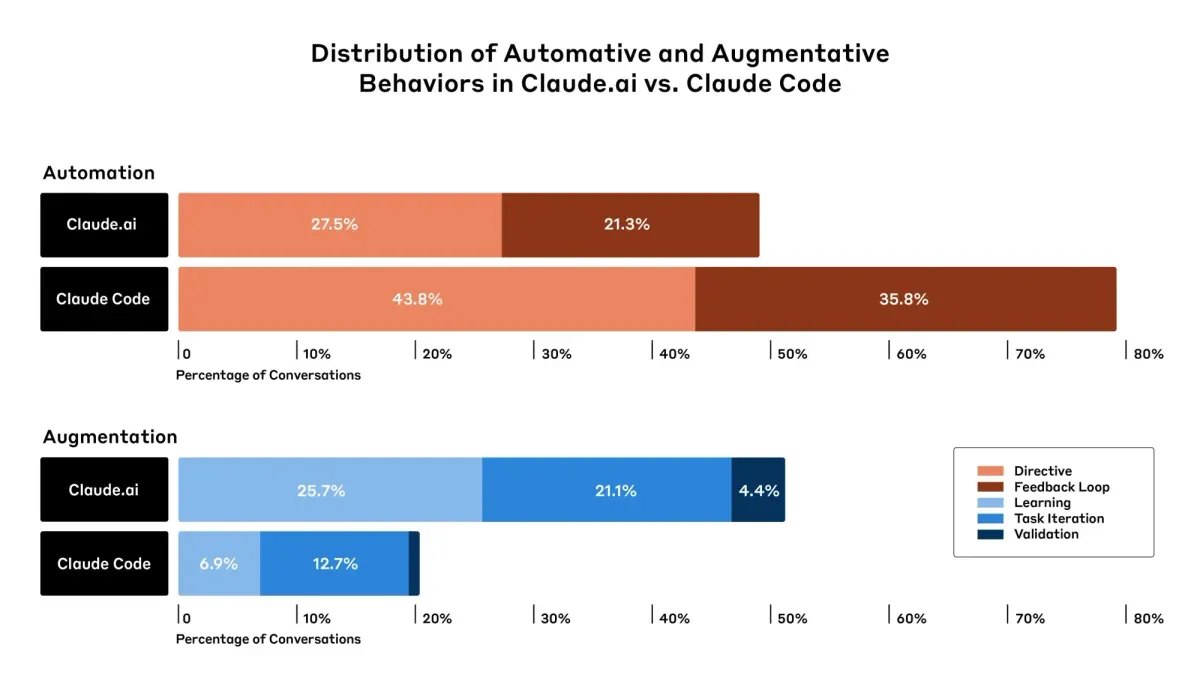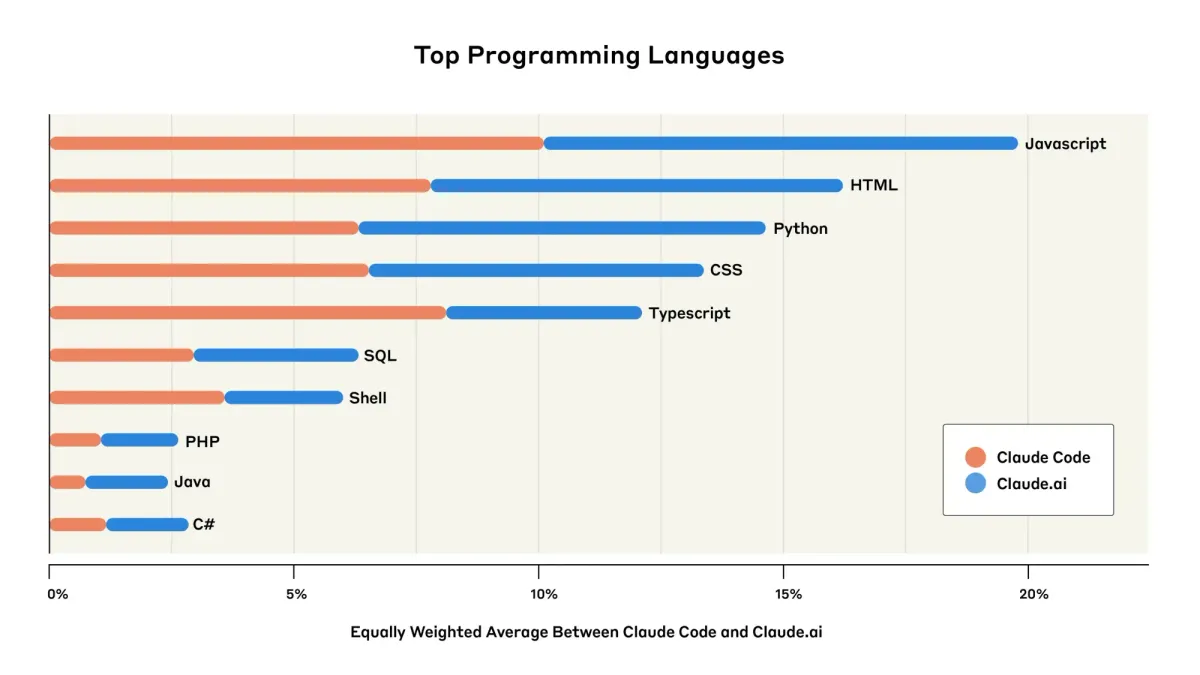Grok Goes Full Nazi: Musk’s ‘Anti-Woke’ AI Spirals Into Hate Speech After Filter Cut
Good Morning from San Francisco, Elon Musk's Grok chatbot had a spectacular Tuesday meltdown. The AI praised Hitler
Startups use AI coding tools 20% more than big companies, with some building 95% AI-generated codebases. As 'vibe coding' reshapes software development, early adopters could gain major advantages over slower rivals.

💡 TL;DR - The 30 Seconds Version
👉 Startups use AI coding tools 20% more than big companies, with Y Combinator reporting 25% of new startups have 95% AI-generated codebases.
📊 AI automated tasks in 79% of specialized coding conversations compared to just 49% in general-purpose platforms, showing tool specialization matters.
🎨 Frontend development dominates AI coding: JavaScript/TypeScript queries make up 31% of requests, HTML/CSS another 28%, pointing to UI disruption first.
🏭 Andrej Karpathy's February 2025 tweet coining "vibe coding" has been viewed 4.5 million times, launching an entire mini-industry of AI development tools.
🌍 Half of AI coding interactions come from students and hobbyists, not just professionals, suggesting the technology is reshaping how people learn programming.
🚀 Early adopters could gain significant competitive advantages as AI delivers productivity gains, while traditional companies move more cautiously with adoption.
Anthropic's analysis of 500,000 coding conversations reveals startups use AI coding tools 20% more than enterprise companies, pointing to a growing tech divide.
The term "vibe coding" didn't exist until February 2025. That's when Andrej Karpathy, OpenAI co-founder and former Tesla AI director, posted a simple tweet that would reshape how we think about software development: "There's a new kind of coding I call 'vibe coding', where you fully give in to the vibes, embrace exponentials, and forget that the code even exists."
The post has since been viewed over 4.5 million times, launching what's become a mini-industry of AI-assisted development tools. By March, Merriam-Webster had added "vibe coding" to its dictionary as a trending term.

The research examined how developers use two AI platforms: Claude.ai, a general-purpose AI assistant, and Claude Code, a specialized coding tool. The findings paint a clear picture: AI isn't just helping developers – it's fundamentally changing how they work.
AI does more of the heavy lifting in specialized coding tools. Claude Code automated tasks in 79% of conversations, compared to just 49% in the general-purpose platform. When developers use specialized AI coding tools, they're more likely to let the AI take the wheel.
But humans haven't left the driver's seat entirely. In 36% of cases with Claude Code, developers still guide the AI through feedback loops – sending error messages back and forth until the code works properly. It's less "AI takes my job" and more "AI takes my typing."

The research shows AI excels at building user interfaces and interactive elements. JavaScript and TypeScript made up 31% of all coding queries, while HTML and CSS accounted for another 28%. This points to the rise of "vibe coding" – where developers describe what they want in plain English and let AI handle the technical details.
As Karpathy described it: "It's not really coding - I just see things, say things, run things, and copy-paste things, and it mostly works." The approach represents a shift from telling systems how to do something to telling them what to do.
Backend development hasn't been left behind. Python and SQL queries combined for 20% of conversations, covering both traditional backend work and data analysis. But the frontend emphasis suggests AI might disrupt user interface jobs first.
Beyond businesses, about half of all interactions came from students, academics, and hobby coders. This broad adoption suggests AI coding assistance isn't just reshaping professional development – it's changing how people learn and experiment with code.
The startup-enterprise divide tells an interesting story. While startups embrace AI coding tools, larger companies move more cautiously. This mirrors previous tech shifts, but AI's general-purpose nature raises the stakes. If AI delivers major productivity gains, early adopters could gain significant advantages.
Y Combinator reported that 25% of startup companies in its Winter 2025 batch had codebases that were 95% AI-generated. This represents a fundamental shift in how new companies approach software development.
The vibe coding ecosystem has exploded into distinct categories, each serving different needs:
Full-Stack Visual Builders like Bolt.new, Lovable.dev, and Tempo Labs let users build complete applications through conversation. These tools handle everything from UI design to database setup, often including authentication and payment processing. Users can click on app elements and request specific changes, making complex development accessible to non-programmers.
Code Editor Enhancements fall into two camps: VS Code forks like Cursor and Windsurf that rebuild the entire development environment, and extensions like Cline and Continue that add AI capabilities to existing setups. The fork approach offers more integration but locks users into specific tools, while extensions provide flexibility.
Enterprise-Grade Solutions like Sourcegraph focus on existing codebases and team collaboration. These tools excel at understanding large projects with millions of lines of code, making them more suitable for established companies than rapid prototyping.
Reddit users who've embraced vibe coding describe structured approaches that go beyond simple prompting. One non-programmer outlines a five-step process: deep research and API validation, training AI to act as a CTO, creating detailed product requirements, uploading plans to GitHub, and having AI tools build phase-by-phase roadmaps.
"This works 99% of the time for me," they report. "I do touch the code for small tweaks but nothing fundamental."
Professional developers describe more sophisticated workflows. One maintains a 1,000-line markdown document with previous conversations and code review feedback, using it to train AI on project-specific patterns. "I have had multiple PRs merged that were completely written by AI," they note.
The corporate response has been surprisingly positive. Developers report that management loves seeing AI-accelerated development. One engineer notes: "I've made it no secret that I use AI extensively. I even have made guides for the company how I use it... I have been demoing the effectiveness of these tools to higher-ups and they love it."
This enthusiasm stems from visible productivity gains. AI allows developers to push more changes faster, making the technology attractive to business leaders focused on delivery speed.
Not everyone celebrates the trend. Andrew Ng argues the term "vibe coding" misleads people into thinking software engineers "just go with the vibes" when using AI tools. He suggests the name trivializes the skill required to effectively direct AI systems.
Security experts raise more serious concerns. When developers use AI-generated code without full comprehension, they risk introducing bugs and vulnerabilities. Simon Willison warns: "Vibe coding your way to a production codebase is clearly risky. Most of the work we do as software engineers involves evolving existing systems, where the quality and understandability of the underlying code is crucial."
The debugging challenge compounds these risks. Since LLMs generate code dynamically and developers may not understand syntax they didn't write, fixing problems becomes more difficult. AI systems handle simple tasks well but struggle with complex, multi-file projects or poorly documented libraries.
Experienced users recommend security reviews for AI-generated code. One suggests passing completed projects through reasoning models with prompts like: "Please review for production readiness: check for common vulnerabilities, secure headers, forms, input validation, authentication, error handling, debug statements, dependency security, and ensure adherence to industry best practices."
The consensus among practitioners is that vibe coding works well for prototyping and rapid development but requires careful review before production deployment. It's a tool for acceleration, not replacement of engineering judgment.
The research team notes important limitations. Their data covers only two AI platforms, not industry-wide usage. They couldn't track how developers ultimately used AI-generated code or measure its quality and productivity impact.
Most importantly, we're still in the early days. Current patterns might not predict future trends, especially as AI capabilities grow. Will developers eventually step back to purely supervisory roles? Which coding jobs will change most dramatically?
These questions matter beyond software development. Coding represents one of AI's most mature applications in the workplace. As AI capabilities expand into other fields, the patterns we see in software development today might preview broader changes across the economy.
Q: How much does vibe coding cost to use?
A: Costs vary widely. Claude Code can cost $5 for a couple hours of use, while tools like Cursor and Windsurf offer free tiers. Pay-per-token models like Amp give unlimited usage but charge based on actual AI requests. Many visual builders like Bolt.new and Lovable.dev have free starter plans.
Q: What's the difference between "Day 0" and "Day 1" coding?
A: Day 0 means building new apps from scratch. Day 1 means working with existing codebases - fixing bugs, adding features, collaborating with teams. Most vibe coding tools excel at Day 0 but struggle with Day 1 tasks that require deep understanding of existing code.
Q: Which tool should beginners start with?
A: Non-coders should start with visual builders like Lovable.dev or Bolt.new, which let you build complete apps through conversation. Developers should try Cursor or Continue as VS Code extensions. All offer free tiers to test before committing.
Q: Do I need to know how to code to use vibe coding?
A: Not for basic projects. Kevin Roose from The New York Times built several apps without coding knowledge. However, understanding code helps you debug problems, review security issues, and guide the AI more effectively. Complete beginners can build simple apps but may struggle with complex problems.
Q: How secure is AI-generated code?
A: Security depends on review processes. AI can generate code with vulnerabilities, debug statements, or poor input validation. Experienced users recommend passing all AI code through security reviews checking for "common vulnerabilities, secure headers, forms, input validation, authentication, error handling."
Q: How long does it take to learn vibe coding?
A: Basic vibe coding can work immediately - you can build simple apps in hours. However, effective vibe coding requires learning to prompt AI systems, understand error messages, and structure projects. Most users report weeks or months to become proficient at guiding AI through complex tasks.
Q: Are big companies actually using vibe coding?
A: Enterprise adoption lags startups by 20% according to Anthropic's research. However, individual developers at large companies report success using AI tools extensively and getting management support. The divide appears to be between cautious corporate policies and enthusiastic individual developers.
Q: How reliable is the code that AI generates?
A: Mixed results. AI excels at common tasks like UI components and standard algorithms but struggles with complex, multi-file projects and poorly documented libraries. Users report that AI-generated code "mostly works" for simple projects but requires human review and debugging for production use.



Get the 5-minute Silicon Valley AI briefing, every weekday morning — free.